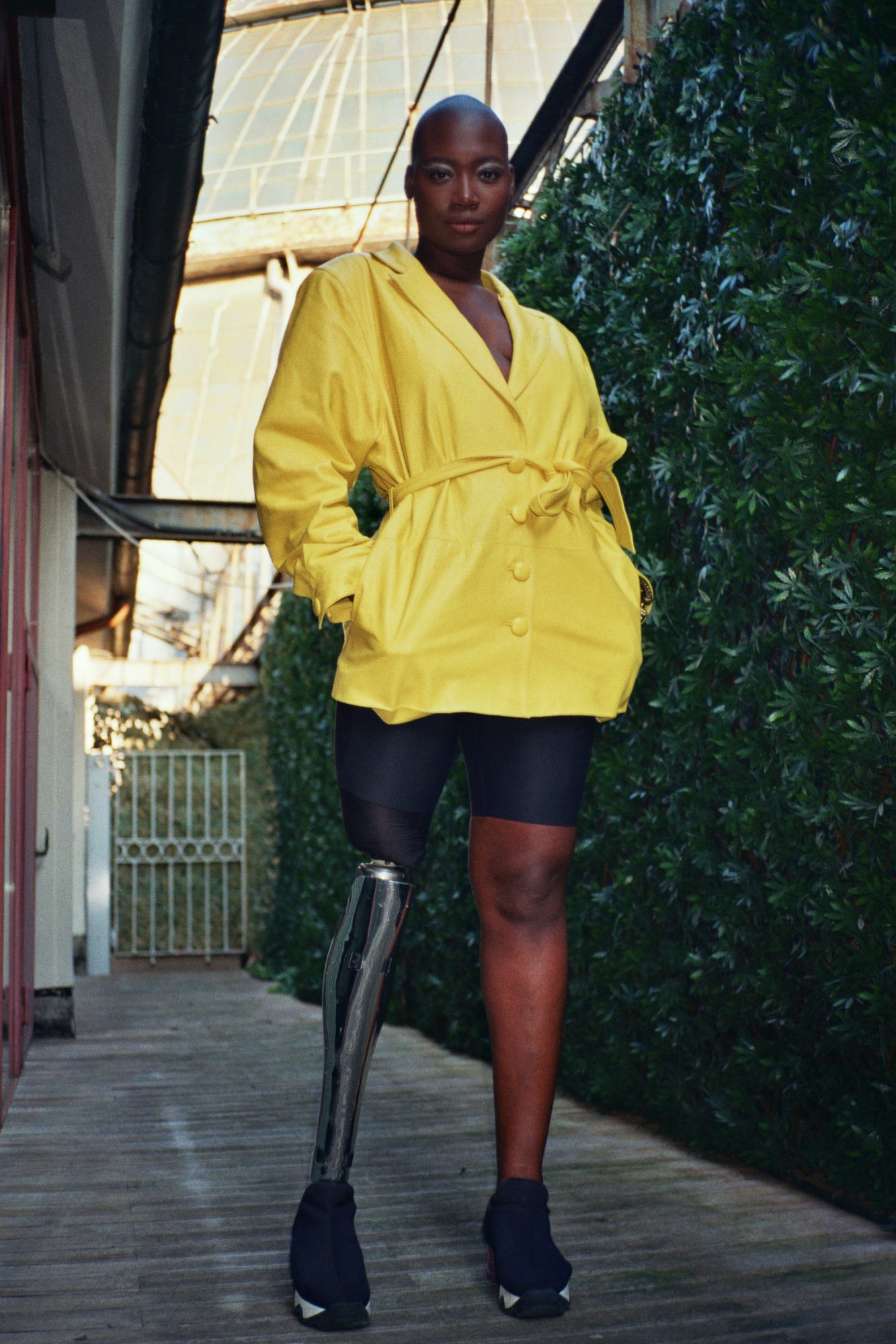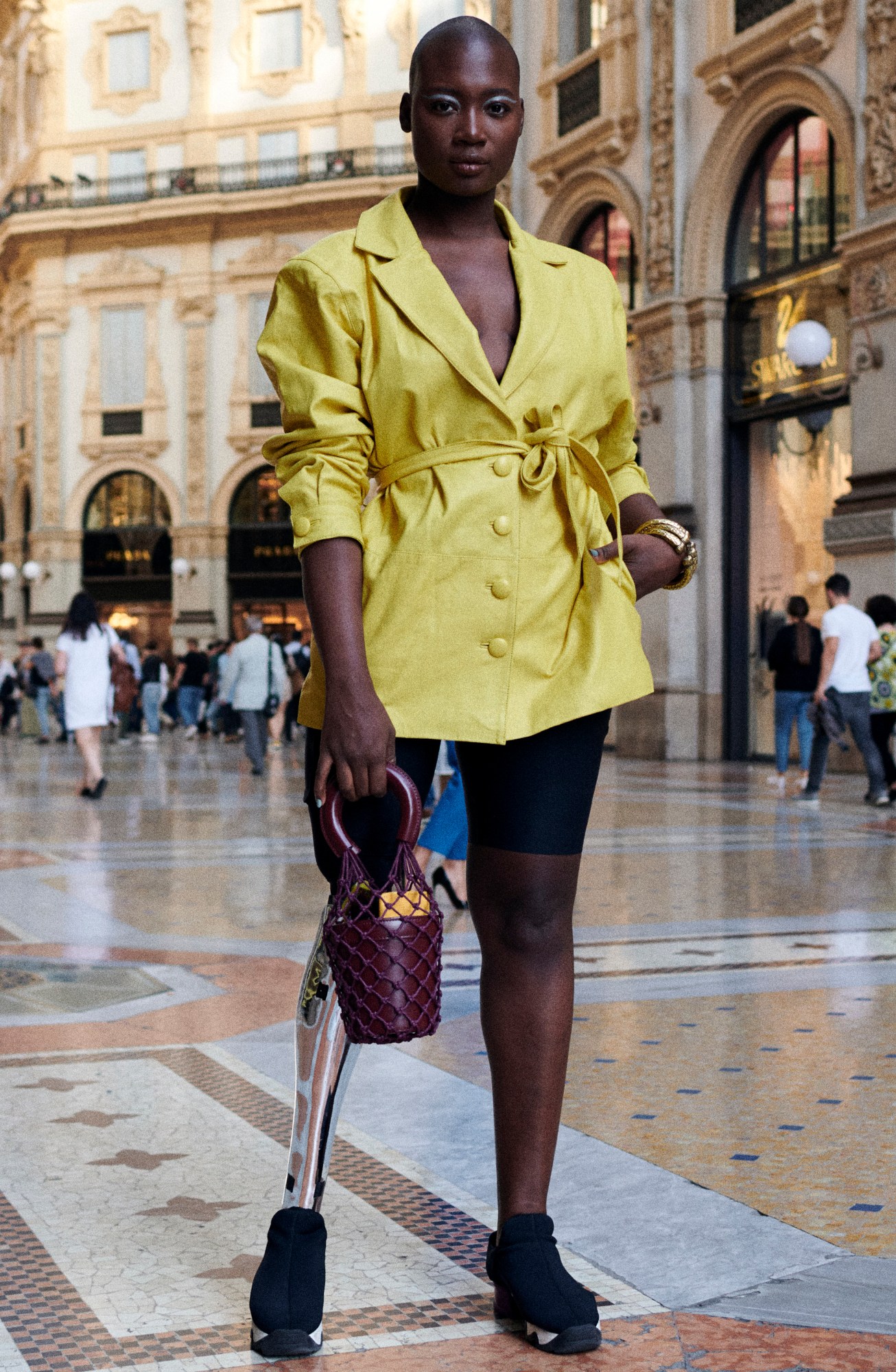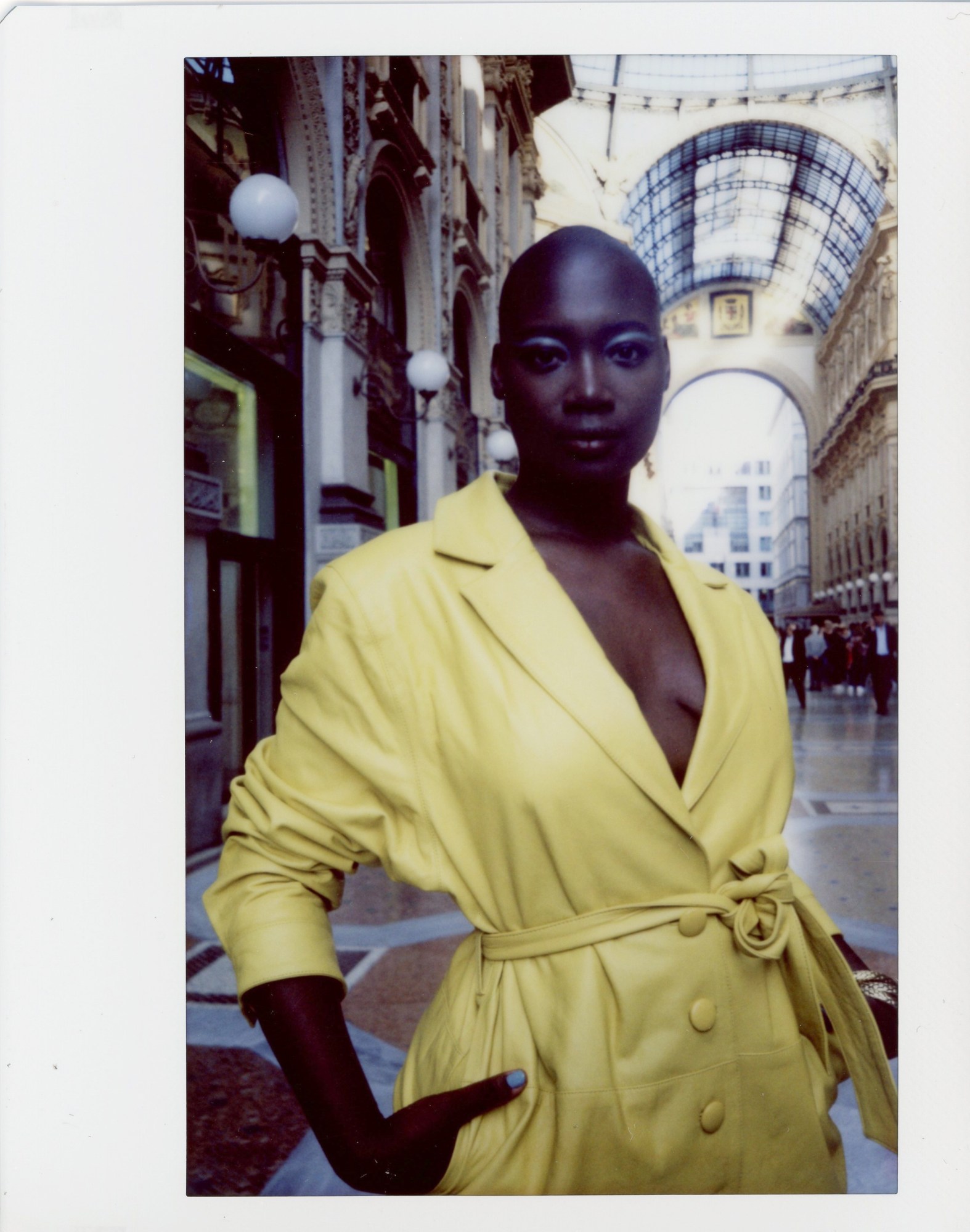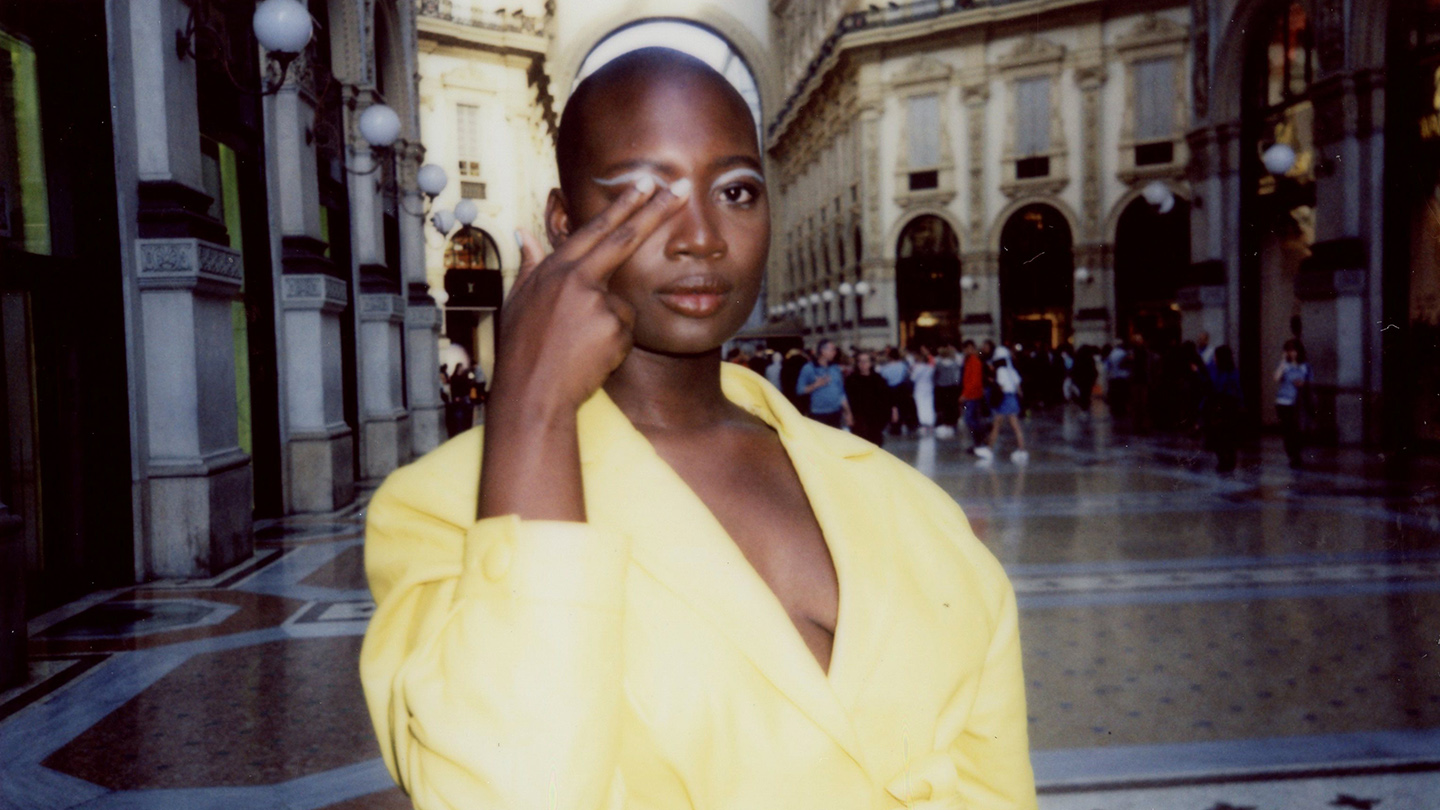I admit it. I spend way too much time on Instagram. Every day I research interesting feeds and accounts, but it doesn’t happen that often that I fall in love at first sight right there and then on the ‘gram. But with Mama Cax it was different, because I was immediately and completely starstruck. First of all, I was amazed by her regal and sophisticated beauty; to me she had the air of an ancient and powerful goddess. Then I discovered her vital energy, her bravery and generosity. I obviously sent her a DM straight away and she answered saying that she was going to be in Milan for a fashion event. Sometimes certain situations happen just like that, like magic. We met and I asked her to talk about her childhood in Haiti, the months spent in hospitals in the US, how expensive prosthesis are, her blog and the look she wore for Savage x Fenty by Rihanna.
First of all I wanted to ask about your name, Cax.
It’s actually my nickname, my real name is Cacsmy. Mama Cax is the name I use for my travel blog.
I know you are Haitian-American, in which country did you spend your childhood?
I was born in Brooklyn, NYC. Then my family moved to Montreal, and when I was still very little we moved to Haiti in Port-au-Prince, where I spent most of my childhood with my four sisters. We lived there for ten years, then we moved back to NY when I was 15.
How was it growing up in Haiti? It’s a country of which it is not known much, full of contradictions yet culturally very active. It has a very important history.
I went there when I was 5 years old. When you’re young you never seem to perceive the world that surrounds you in a lucid way, and you don’t realize certain things until you grow up. For me it was like living in heaven. The weather was always warm and and we used to go to the seaside every weekend. Growing up, I became more and more aware of the corruption, the instabilities, the huge gap between rich and poor; even if I think still now that all these issues never once ruined the culture of my country.
Haiti is the first independent black republic in history; slaves organized and staged the Revolution against the French colonizers. I think that through time we managed to keep the strength that distinguishes us as a country, and we demonstrate it in every single thing we do. We experienced, and still do, very difficult and drastic situations, but even after the tragedy of the 2010 earthquake, as a nation and as a society we almost immediately went back to work and sent our kids back to school. My style and my strength are a direct consequence of this cultural context.

You are emblematic of resilience, do you think this energy is closely linked to your Haitian origins?
Absolutely. Haitian women are extremely strong. They treat us as adults from a very young age, which isn’t always a good thing, but this kind of education forces us to be more mature. It’s a double-ended sword, in a way it’s a good thing because it makes us more independent and able to resolve our own traumas, on the other hand it makes us unable to think that moments of difficulty and mental illnesses have to be taken seriously. We don’t think that depression or any kind of mental illness exists, and women are expected to be strong always and anyways.
This strong sense of community and sharing is intrinsic in Haitian culture, especially between women. It’s a way of living that not every culture in the world share.
Haitians have a very deep and important consideration of family. Women tend to work together and help each other out constantly. We believe in ‘it takes a village..’. When I had to go back to the US, I spent several months at the hospital and my mother couldn’t have managed on her own. My grandmother, my aunt, family friends and people I didn’t even know were a huge support for me and my mother. Haitian people carry this sense of community wherever they go, even if we are not in Haiti. Wherever we are we support each other.
So, did you move back to the US when you discovered you had cancer?
Yes, we decided to move back to the US to start the treatments. When I arrived I was diagnosed with bone cancer and it was already metastasizing to my lungs. I did cycles of chemotherapy and we thought that a hip transplant would be enough, but I kept rejecting the bone marrow. The second solution was amputation. This opened my eyes to a completely new world, and I started writing my blog to talk about body-positivity. It became my mission to give a voice to girls like myself and push them to love themselves exactly as they are. It may seem banal, but it’s a very profound concept. I experienced depression in my own skin, I know exactly how it feels, I know that it paralyzes and it makes you feel like you are not worth it, that you’re not worthy of your dreams, of being loved. I understood that most of my problems were caused by the fact that I didn’t accept myself, and from the moment I overcame this depressive condition, I finally started to love myself. I want that other people too learn how to do this and stop thinking that they are not worthy enough. When I started modeling I didn’t believe in myself. I told myself “What am I doing here? I have a prosthetic leg, I have crutches, I’m not skinny enough.” But I persevered and I told myself I could make it.
On a practical level, are prosthesis costs covered by insurance?
Many people don’t have the kind of health insurance that would cover the purchase of prosthesis. They are very expensive, and if you’re lucky you can enter the waiting list in order to get State funding. For me it wasn’t that fundamental to have a technologically advanced prosthesis. I wanted them to be beautiful, cool, I didn’t want the classic ones. So I managed to become ambassador of a company which produces covers for prosthesis, and by working for them, I was able to collect between 15 and 18 prosthesis, very artistic and particular.
But all of them cost from $200 to $400, and therefore many people can’t afford them. I know that more and more people are experimenting with creating their own, through 3D printing and just by getting creative. Anyways, when girls who follow me started asking specific questions about where to buy them, about the fact that they are way too expensive, whether they could buy them in Europe; at that moment I realized that these prosthesis certainly put me in the position of having a voice, and be heard from other people like me, they ultimately made me feel beautiful again; but I also felt that I had to explain to these girls that I don’t need, and that they don’t need this accessory in order to feel amazing and stunning. What I’m trying to do is to go out as much as possible without my prosthetic leg and try to not use them for shootings. I hope that this will push girls like me to feel beautiful and free without expensive accessories.
Maybe one day these companies will decide to produce a cheaper line…
I think that the main problem is that people like me are able to choose whether they want to wear a prosthesis or not. It’s not a popular market because there isn’t a definitive aesthetic. People don’t try to make their prosthesis beautiful or customize them as they like. Instead, I love the idea that people will be able to make their own, that’s why I hope that 3D experimentation will continue.

You have studied in many and different countries, was this moving around that made you start a travel blog?
When I finished college I decided to start my blog, because I wanted to travel around South-East Asia. There are not that many blogs that describe how difficult it is to travel as a disabled person. I wanted to create a platform that could inform people like me what to do in case a crutch breaks, or if they have a problem with their prosthesis while finding themselves away from home. These were all pieces of information that I had to know before going on my trip, and since I couldn’t find them anywhere I decided to start documenting and gathering this information by myself.
So I started my blog, which very easily started to gravitate towards fashion, which is what I love the most. To be honest the blog became a platform where I talk about everything I love, and about what interests me the most, always from the point of view of a black woman with a disability. There are so many bloggers in the world, but maybe it’s more interesting if there’s a different point of view. When I talk about travels, I always talk about how accessible that country or city is for a person with disabilities. When I talk about fashion, I focus on those brands I know to be more inclusive.
It’s rare that people get interested in these issues, unless they experience it themselves, do you think?
This is the reason why there are always two aims when you want to express a strong message. The first one is directed to people without disabilities, who might find themselves in the same situations as people who have them. For example pregnant women, or someone carrying a stroller, or if you are old, or maybe if your leg is broken. The second part of the message is directed to disabled people, in order to reassure them that anything they want to do or dream to do is possible, even if at first sight seems impossible. These are just challenges which can be overcome, and there are ways to overcome them.
What is the country you discovered to be the most prepared for the necessities of disabled people, the most forward-thinking and advanced?
I was in Denmark recently and I thought that their system wasn’t bad at all. From the most minute details, like getting on the bus, accessing the subway, or the sidewalk around the city. I would say that this country is the number one, but also London surprised me in a positive way. In America, I know for a fact that Eugene, Oregon, is very prepared to meet these necessities. When I document these things I obviously have to think about all kinds of disabilities, there are many issues to think about and you have to be very careful when thinking about public transport or common spaces. NYC is hell, even if I live there and I think it’s one of the most beautiful cities in the world.

How was it like to work with Rihanna? I saw the look you were wearing for the Savage x Fenty show, it was so sexy!
It was amazing. She called me two days before the show, and on the same day we had four rehearsals. She was happy I was there with the other models and I was like: ‘I am the one who is happy to be here!’. It was so cool and exciting. I can’t imagine any other city like NYC that has such an inclusive modeling scene.
Tell us more about your look for Savage x Fenty…
Oh God, it was total black. I was wearing a super tight lace corset, extremely sexy, 10 den tights, night gloves and a mask with a veil, very seductive.
What are you future plans?
One of my dreams is to create an IGTV. I don’t want to do podcasts because I’m a very visual person. My idea is to present to my audience the people with disabilities who are close to me, and have regular conversations with them, touching any topic. Food, clubs, vintage shops, sex, body-positivity, anything really a part from talking directly about disability. I want this to be an educational project. I don’t want the focus to be about disabilities, on the contrary, the focus has to be on normality. Through modeling I also want to push boundaries, for instance there are no disabled people who have modeled for a wedding campaign. I want to present myself everywhere, especially where diversity is not yet normalized.

Follow her on Instagram and Facebook
Credits
Text Gloria Maria Cappelletti
Photography Rosario Rex di Salvo
This article originally appeared on i-D IT.
